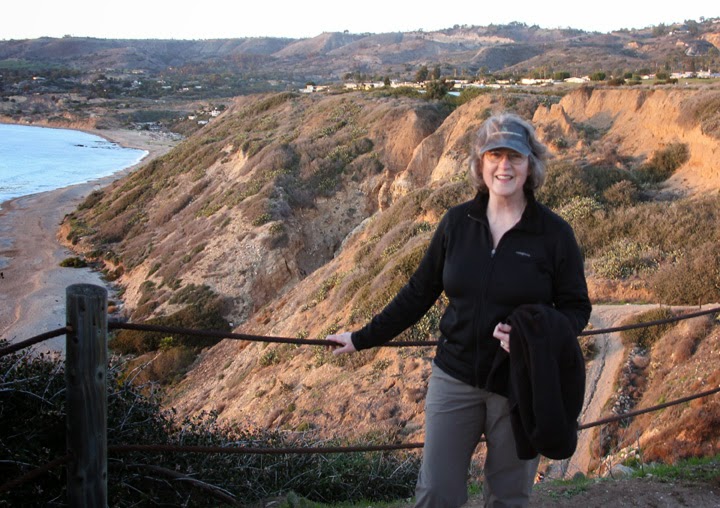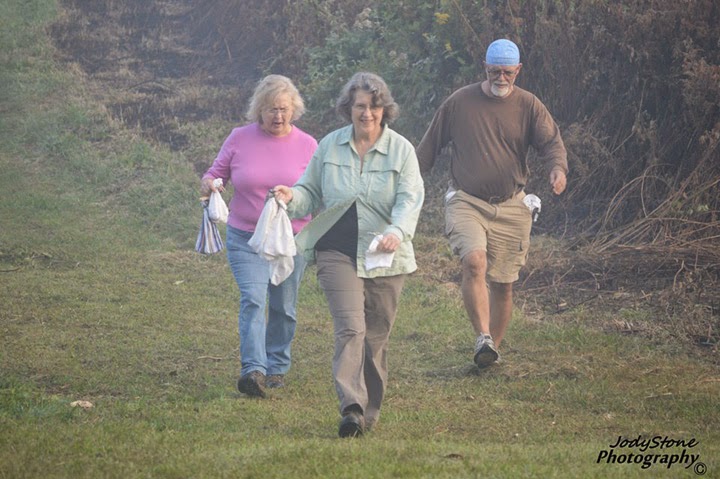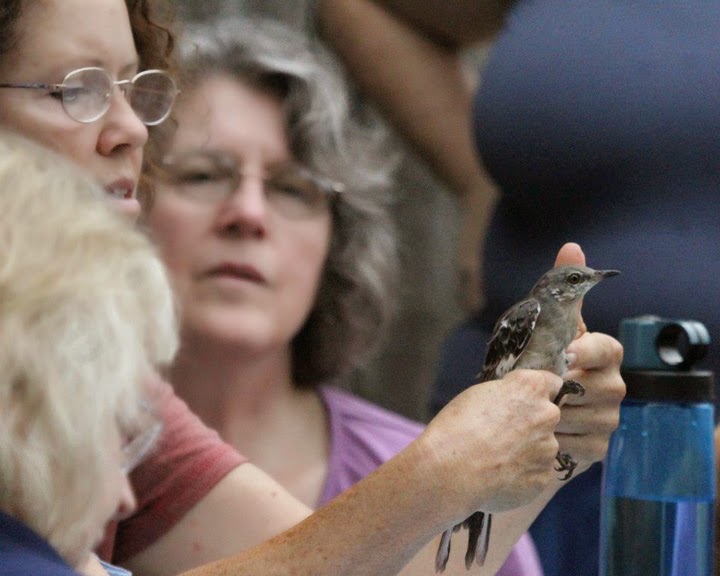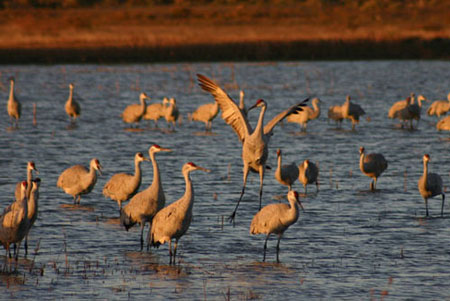 On May 30th I visited Ijams Nature Center in Knoxville and had lunch with friend, Stephen Lyn Bales, a naturalist, fellow nature blogger and interpreter at Ijams. During our picnic lunch, this Yellow-throated vireo was singing pretty continuously and Stephen Lyn identified him by song. Catching a glimpse of the bird, I snapped a few images and the one below gave me the visual confirmation that I needed to find him in my Peterson's field guide. The vireos are new to me, but it seems this is my vireo year. Within the last month, I have seen and heard the Yellow-throated and the Blue-headed vireos and heard the song of the Red-eyed vireo.
On May 30th I visited Ijams Nature Center in Knoxville and had lunch with friend, Stephen Lyn Bales, a naturalist, fellow nature blogger and interpreter at Ijams. During our picnic lunch, this Yellow-throated vireo was singing pretty continuously and Stephen Lyn identified him by song. Catching a glimpse of the bird, I snapped a few images and the one below gave me the visual confirmation that I needed to find him in my Peterson's field guide. The vireos are new to me, but it seems this is my vireo year. Within the last month, I have seen and heard the Yellow-throated and the Blue-headed vireos and heard the song of the Red-eyed vireo. I found some neat information in my Atlas of Breeding Birds of Tennessee about Yellow-throated vireos and cowbird predation. It doesn't always go the cowbird's way. "The Yellow-throated Vireo is frequently parasitized by Brown-headed Cowbirds and may occasionally build a new nest floor over a cowbird egg. [!] ....I have three times observed adult vireos feeding fledgling cowbirds....On 28 June 1986 a pair of vireos was seen fighting off a female cowbird attempting to approach the vireo's nest."--Charles P. Nicholson.
I found some neat information in my Atlas of Breeding Birds of Tennessee about Yellow-throated vireos and cowbird predation. It doesn't always go the cowbird's way. "The Yellow-throated Vireo is frequently parasitized by Brown-headed Cowbirds and may occasionally build a new nest floor over a cowbird egg. [!] ....I have three times observed adult vireos feeding fledgling cowbirds....On 28 June 1986 a pair of vireos was seen fighting off a female cowbird attempting to approach the vireo's nest."--Charles P. Nicholson.I also enjoyed the nest description from the atlas: "The nest is built of bark strips, plant fibers, and grasses held together with spider webs and lined with fine grasses or hair. The outside is decorated with lichens, moss, and masses of spider webbing, and Bent (1950) described it as the handsomest nest of any vireo." The account also reports that both the male and female sing frequently while incubating. (I love this book!)
 And that brings me to the thistle. Between the table where we ate and the vireo singing, there was a garden of bull thistles with sunlight and butterflies dancing on the blossoms. I could barely eat lunch for chasing the butterflies with my camera. And as I looked through the lens, I got an intimate view of the fritillary's proboscis as it probed the blossom and that fun little insect expression!
And that brings me to the thistle. Between the table where we ate and the vireo singing, there was a garden of bull thistles with sunlight and butterflies dancing on the blossoms. I could barely eat lunch for chasing the butterflies with my camera. And as I looked through the lens, I got an intimate view of the fritillary's proboscis as it probed the blossom and that fun little insect expression! This only makes me want to know more, like where exactly is the nectar in that bull thistle blossom and how does that prob get to it? The more I watch, the more fascinating nature becomes and the more it sparks curiosity. This could keep me going for days!
This only makes me want to know more, like where exactly is the nectar in that bull thistle blossom and how does that prob get to it? The more I watch, the more fascinating nature becomes and the more it sparks curiosity. This could keep me going for days!
 And below, some Columbine blossoms that I passed along the way. Already past their prime, they were hanging like delicate beauty bells among the stiffened pods that are broadcasting seed for the next generation.
And below, some Columbine blossoms that I passed along the way. Already past their prime, they were hanging like delicate beauty bells among the stiffened pods that are broadcasting seed for the next generation. Linked to Bird Photography Weekly #44, at Birdfreak.com to promote the conservation of our world's birds.
Linked to Bird Photography Weekly #44, at Birdfreak.com to promote the conservation of our world's birds.

 I am a writer as well as an
I am a writer as well as an  And so there is this dance, this back and forth journey, both creative endeavors, both requiring deep commitment, both rewarding in and of themselves.
And so there is this dance, this back and forth journey, both creative endeavors, both requiring deep commitment, both rewarding in and of themselves.  The
The  In the meantime, I want to introduce you to several other Red-shouldered hawk lovers and observers that I have met along the way. This has been another amazing part of the journey, the connection that
In the meantime, I want to introduce you to several other Red-shouldered hawk lovers and observers that I have met along the way. This has been another amazing part of the journey, the connection that 
 To see my entire series of posts on this family of Red-shouldered hawks, click this
To see my entire series of posts on this family of Red-shouldered hawks, click this 






 She was a sweet surprise for a 90-degree, muggy summer solstice hike on Father's Day. And because I had the good fortune of being with an experienced birder, I also became more familiar with several other warblers by song, the Chestnut-sided, Hooded, Pine and Worm-eating warblers. Close by, we also enjoyed the persistent singing of both Red-eyed vireos and Blue-headed vireos. In all, we saw or heard 20 species.
She was a sweet surprise for a 90-degree, muggy summer solstice hike on Father's Day. And because I had the good fortune of being with an experienced birder, I also became more familiar with several other warblers by song, the Chestnut-sided, Hooded, Pine and Worm-eating warblers. Close by, we also enjoyed the persistent singing of both Red-eyed vireos and Blue-headed vireos. In all, we saw or heard 20 species. In the image below from Look Rock tower, you can see a few of the mountain ridges through the mist.
In the image below from Look Rock tower, you can see a few of the mountain ridges through the mist. Warblers--another reason to love the mountains.
Warblers--another reason to love the mountains.


 When I have time to sit for a while and enjoy the morning air, my first smile comes with the arrival of the titmouse family. They seem to pop up from every limb, the juveniles calling out with their eager, "zhree, zhree, zhree, zhreeaaal", that last note being more of a squeal than a note.
When I have time to sit for a while and enjoy the morning air, my first smile comes with the arrival of the titmouse family. They seem to pop up from every limb, the juveniles calling out with their eager, "zhree, zhree, zhree, zhreeaaal", that last note being more of a squeal than a note.






 This was one huge
This was one huge  This is not a faint-of-heart predator! I think he is a member of the Clubtail family and possibly a species called, Dragonhunter. But beyond that 'possible' ID, I can't venture. Even though I have always found dragonsflies
This is not a faint-of-heart predator! I think he is a member of the Clubtail family and possibly a species called, Dragonhunter. But beyond that 'possible' ID, I can't venture. Even though I have always found dragonsflies  Of the Clubtails, my Stokes, Beginner's Guide to Dragonflies says: "The clubtails are one of the most diverse and challenging groups of dragonflies in the world....for many closely related species, even a good look at all of these features will not suffice; only an in-hand examination of anatomical features will permit certain identification. Even experts must let many pass simply as "clubtail species."
Of the Clubtails, my Stokes, Beginner's Guide to Dragonflies says: "The clubtails are one of the most diverse and challenging groups of dragonflies in the world....for many closely related species, even a good look at all of these features will not suffice; only an in-hand examination of anatomical features will permit certain identification. Even experts must let many pass simply as "clubtail species." Having read that, I know my limitations. But I can readily say he was gorgeous! When he was whirling around in the turbulence, I found myself primed to duck if he came my way. This made me laugh. I've never had that reaction to a dragonfly before. This guy was more like a helicopter!
Having read that, I know my limitations. But I can readily say he was gorgeous! When he was whirling around in the turbulence, I found myself primed to duck if he came my way. This made me laugh. I've never had that reaction to a dragonfly before. This guy was more like a helicopter!  I thought about entitling this post, "leaves, leaves, leaves!" But each time I think about complaining about what I can't see because of the leaves, I remind myself that this incredibly thick canopy protected the
I thought about entitling this post, "leaves, leaves, leaves!" But each time I think about complaining about what I can't see because of the leaves, I remind myself that this incredibly thick canopy protected the  The real fun of this visit was the amazing moment of seeing the juvenile, a stationary mass that on passing glance as I lowered my binoculars, looked like a clump of fallen leaves. That I spotted him at all was the unexpected peak of Friday's visit. Seeing him clearly confirmed what I could only speculate before, that he/she has fledged and is flying from branch to branch within the nesting territory but not yet hunting.
The real fun of this visit was the amazing moment of seeing the juvenile, a stationary mass that on passing glance as I lowered my binoculars, looked like a clump of fallen leaves. That I spotted him at all was the unexpected peak of Friday's visit. Seeing him clearly confirmed what I could only speculate before, that he/she has fledged and is flying from branch to branch within the nesting territory but not yet hunting.  On a prior visit, I witnessed the male's strike and heard the calling of what I believed to be two juveniles as the male brought the prey to the nest. The parent then flew to the back of the nest house. This was another moment of lucky timing. My reading confirms this is typical care of hawk young at this age of maturity. The juveniles are now 48-51 days old. The parents leave the juveniles alone for much of the day, visiting only long enough to drop off prey.
On a prior visit, I witnessed the male's strike and heard the calling of what I believed to be two juveniles as the male brought the prey to the nest. The parent then flew to the back of the nest house. This was another moment of lucky timing. My reading confirms this is typical care of hawk young at this age of maturity. The juveniles are now 48-51 days old. The parents leave the juveniles alone for much of the day, visiting only long enough to drop off prey.  Even though the image above is not clear, you can still see a small amount of white and brown streaked breast feathers.
Even though the image above is not clear, you can still see a small amount of white and brown streaked breast feathers. Sketchbook note: "I could not have been more surprised. I was looking at the nest through my binoculars and noticed what I thought was a clump of leaves. A second look and I discovered this beautiful juvenile perched on a low branch near the nest. Today marks 48 days counting from April 26 when I first saw a nestling. The parents hunt now, drop prey off and leave again. Although I heard calling in the distance, the adults did not return during my 3- hour visit."
Sketchbook note: "I could not have been more surprised. I was looking at the nest through my binoculars and noticed what I thought was a clump of leaves. A second look and I discovered this beautiful juvenile perched on a low branch near the nest. Today marks 48 days counting from April 26 when I first saw a nestling. The parents hunt now, drop prey off and leave again. Although I heard calling in the distance, the adults did not return during my 3- hour visit." I looked up from the blue jay in the previous post and found these two beautiful juvenile downies hanging from the feeder together.
I looked up from the blue jay in the previous post and found these two beautiful juvenile downies hanging from the feeder together.  As you look at the images that follow, you will see the one on the left plunged her beak into the suet cake so eagerly that it came back coated in dough. She made a few attempts to peck at the dough afterward but then began to look a bit bewildered.
As you look at the images that follow, you will see the one on the left plunged her beak into the suet cake so eagerly that it came back coated in dough. She made a few attempts to peck at the dough afterward but then began to look a bit bewildered. 



 "Okay, I'm headed for a good ole tree trunk to get this mess off my nose!"
"Okay, I'm headed for a good ole tree trunk to get this mess off my nose!"  Meantime her buddy had the feeder to herself for a few minutes before she too flew to the tree. In this image you can see her juvenile belly speckles more clearly.
Meantime her buddy had the feeder to herself for a few minutes before she too flew to the tree. In this image you can see her juvenile belly speckles more clearly.






